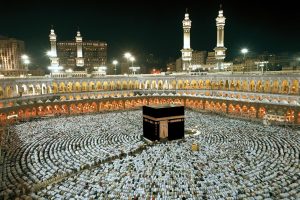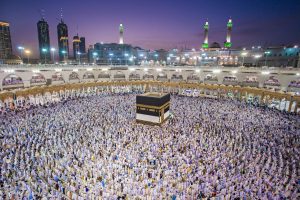
How much do you know about Islam’s holiest site? In this series, we go right to the centre of religion; each article discusses different aspects of the Ka’ba and makes Islam more accessible to readers.
Mansoor Dahri, UK
I hope that the title doesn’t put anyone off; ‘Circle the Cube’ isn’t some strange maths manoeuvre and it isn’t some weird philosophical or artistic paradox like the Möbius strip.
Instead, it refers to something far more complicated and elusive than any of that. It refers to unity and brotherhood among people from different nations.
It refers to something that takes place in the city of Makkah (مَكَّة) during the annual pilgrimage of Hajj (حَجّ), which is a miracle of international solidarity and togetherness that cuts across the artificial borders of this transitory world.
Specifically, it refers to ‘Tawaf‘ (طَوَاف) which is the act of ‘going around’ or ‘circling’ the Ka’ba during Hajj. The word ‘Ka’ba’ (كَعْبَة) is Arabic and means ‘Cube’ because that’s how it’s shaped.
So during Hajj, when Muslims perform Tawaf, we literally circle around the Cube seven times in a counterclockwise direction.
Why do we do this?
Because circles symbolise unity. Not only are circles symbols of the Oneness and Unity of Allah the Almighty, but during Hajj, the act of circling the Ka’ba also symbolises the oneness and unity of the believers.
But what about cubes? Does the shape of the Ka’ba mean anything?
The shape of the Ka’ba is truly unique; there are no ancient buildings quite like it. Only in modern times has the simple scientific elegance of the cube taken hold in the imagination of architects. It’s a useful reminder to Muslims that we should never feel ashamed of ourselves or harbour any kind of inferiority complex. Our religion has never been behind the times but the times have frequently lagged far behind our religion.
Although the Ka’ba technically has six sides as a cube (hence the name of this series ), it only has four walls on a horizontal plane. This symbolises four directions; although the walls are not aligned with the cardinal directions of a compass, they nevertheless symbolise the whole world — people coming from all four directions.
Muslims may come from different nations, tribes and directions but while performing Tawaf during Hajj, they are all united by faith.
During Tawaf, everyone goes in the same direction though they may have come from many different directions in order to attend. Once you have completed the circle, you are right back where you started; the beginning is the end and the end is the beginning.
We may lead very different lives from each other but all of us were born one day and all of us will die some day and we will all return to the Source that sent us here and we will all be held accountable to Him.
About the Author: Mansoor Dahri is an online editor for The Review of Religions. He graduated from UCL in BA Ancient Languages.



Add Comment